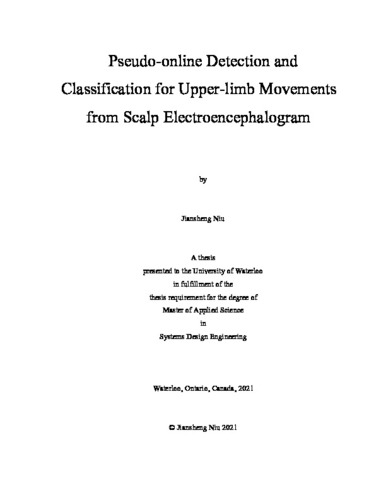| dc.description.abstract | Stroke has been a significant healthcare issue worldwide, leading to motor impairment and complicated rehabilitation procedures, which often last for years after lesion. In recent years, brain-computer interface (BCI) research shed some light on new approaches for motor ability recovery and potential neural plasticity inducement for stroke patients. Electroencephalogram (EEG) is widely used in BCI to measure brain activity. In this thesis study, nine healthy participants were recruited to perform four movements in a self-initiated manner, including left wrist extension (WE_L), right wrist extension (WE_R), left index finger extension (IE_L), and right index finger extension (IE_R). A hierarchical structure was proposed first to detect movement intentions from the rest state and then classify different movement types. Movement-related cortical potential (MRCP) and sensorimotor rhythm (SMR) were believed to associate with movement intention generation in human EEG. Thus, three frequency bands of EEG (0.05-5Hz, 5-40Hz, 0.05-40Hz) containing MRCP or SMR were investigated to provide features for detection and classification algorithms. In detection, a majority voting-based ensemble learning method was proposed to integrate the strongness of three algorithms, including support vector machine (SVM), EEGNET, and Riemannian feature-based SVM. The proposed method achieved an average true positive rate (TPR) of 79.6% ± 8.8%, false positives per minute (FPs/min) as 3.1 ± 1.2 within a latency of 91.4 ± 111.9ms. For classification, an adaptive boosting-based ensemble learning algorithm was proposed to classify movement pairs and four movements in pseudo-online and time-locked analyses. As a result, It proved the feasibility of classifying movements in different arms with higher than significant chance level accuracy. In summary, the proposed system offered a novel solution to decode upper-limb movements for rehabilitation-aimed BCI. | en |

